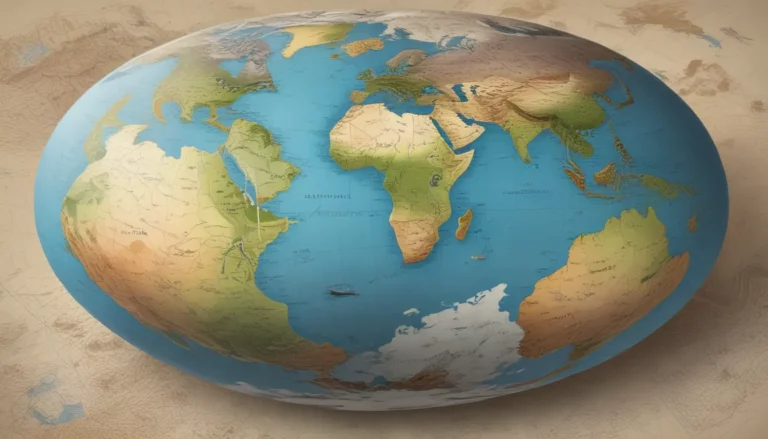A Note About Images: The images used in our articles are for illustration purposes only and may not exactly match the content. They are meant to engage readers, but the text should be relied upon for accurate information.
Coastal erosion, a natural process that has been shaping Earth’s coastlines for centuries, is a phenomenon that deserves our attention. While many of us are familiar with the concept of erosion, there are several surprising facts about coastal erosion that may not be widely known. From the impact on local communities and ecosystems to the staggering amounts of land lost each year, coastal erosion is a force to be reckoned with.
In this article, we will delve into 13 surprising facts about coastal erosion that will provide valuable insights into the extent of the issue and its implications. Whether you have a keen interest in nature, geography, or simply want to learn more about the world around us, these facts are bound to leave you amazed and perhaps inspire a sense of urgency in addressing coastal erosion.
Unveiling the Realities of Coastal Erosion
Coastal erosion is a global issue affecting coastlines worldwide.
Coastal erosion, the gradual wearing away of land, cliffs, and beaches by waves, wind, currents, and tides, is not limited to a specific region. From sandy beaches to rocky cliffs, no coastal area is immune to the relentless forces of erosion.
Climate change exacerbates coastal erosion.
The impacts of climate change, such as rising sea levels, increased storm intensity, and changing weather patterns, have accelerated the rate of coastal erosion in recent years. These environmental changes pose a significant threat to already vulnerable coastlines.
Human activities can contribute to coastal erosion.
Various human activities, including coastal development, sand mining, and improper coastal management, can exacerbate coastal erosion by disrupting natural sediment supply and coastal processes. It is essential to consider sustainable practices to mitigate these impacts.
Coastal erosion can lead to the loss of valuable land and infrastructure.
Homes, businesses, roads, and vital infrastructure in coastal communities are at risk due to coastal erosion. The economic and social disruptions caused by land loss emphasize the importance of addressing erosion effectively.
Erosion can reshape coastlines over time.
The continuous process of coastal erosion can result in the formation of new landforms, such as headlands, beaches, and sandbars. These changes contribute to the dynamic nature of coastal landscapes.
Strategies to Address Coastal Erosion
Beach nourishment is an effective method to combat erosion.
One common approach to mitigating coastal erosion is beach nourishment, which involves adding sediment to eroded beaches to restore their width and volume. This method helps protect coastlines and provide natural defenses against erosion.
Natural coastal defenses play a crucial role in erosion mitigation.
Features like sand dunes and mangroves act as natural buffers, absorbing wave energy and reducing erosion along coastlines. Preserving these natural defenses is essential for sustainable coastal management.
Hard engineering structures can offer temporary protection.
Sea walls and groynes are sometimes used to protect coastlines from erosion. While these structures can provide immediate relief, they often come with environmental impacts and long-term sustainability considerations.
Impacts of Coastal Erosion
Coastal erosion threatens habitats and biodiversity.
The loss of coastal wetlands, dunes, and coral reefs due to erosion jeopardizes the diverse ecosystems they support. Protecting these habitats is crucial for preserving biodiversity and ecosystem services.
Cultural heritage sites are at risk from climate-induced erosion.
Historic landmarks, archaeological sites, and cultural treasures located along vulnerable coastlines face the threat of being lost to erosion. The preservation of these sites is essential for maintaining cultural heritage.
Solutions for Long-Term Resilience
Monitoring and management are key to addressing coastal erosion.
Effective monitoring programs and management strategies are essential for mitigating erosion, protecting coastal assets, and ensuring sustainable coastal development. Collaboration between communities and governments is crucial in this effort.
Sustainable planning and adaptation strategies are critical for resilience.
By considering the impacts of climate change, implementing resilient designs, and promoting coastal conservation, we can build a more sustainable future for our coastlines. Long-term planning is essential for mitigating the effects of coastal erosion.
Conclusion
In conclusion, coastal erosion is a complex natural process with significant implications for coastal communities and ecosystems. The 13 surprising facts highlighted in this article shed light on the scale and urgency of addressing coastal erosion. Understanding the causes and impacts of erosion is essential in developing effective strategies for mitigation.
By implementing sustainable coastal management techniques and raising awareness about the consequences of erosion, we can work towards protecting vulnerable areas from further degradation. Each individual has a role to play in preserving our coastlines through responsible actions and support for conservation initiatives.
FAQs: Answering Your Questions
Q: What causes coastal erosion?
A: Coastal erosion can be caused by wave action, storms, sea level rise, and human activities like coastal development and sand mining.
Q: Which areas are most affected by coastal erosion?
A: Vulnerable regions include those with soft cliffs, sandy beaches, and low-lying coastlines, such as the Eastern coast of the United States and various coastal areas in Southeast Asia.
Q: How does coastal erosion impact ecosystems?
A: Erosion can lead to the loss of habitats like mangroves and coral reefs, disrupting biodiversity and local food chains.
Q: Can coastal erosion be prevented?
A: While prevention is challenging, measures like beach nourishment and dune stabilization can help mitigate erosion impacts.
Q: What are the long-term consequences of coastal erosion?
A: Long-term consequences include land loss, infrastructure damage, community displacement, and increased vulnerability to coastal hazards.
Q: How can individuals contribute to coastal erosion management?
A: Individuals can support sustainable coastal practices, reduce pollution, participate in beach cleanups, and back local conservation efforts.
By taking proactive steps to address coastal erosion, we can create a more sustainable future for our coastlines and ensure their preservation for future generations. Let’s work together to safeguard these invaluable coastal environments.






